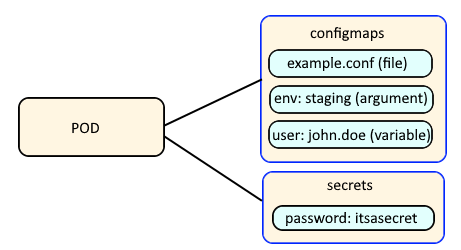
If you are not familiar with the oc command, refer to OpenShift - Getting Started with the oc command.
There are different ways to configure a container with environment variables.
- In a deployment YAML file
- Using configMapRef (all of the key/value pairs in the config map will be used)
- Using configMapKeyRef (specific key/value pairs in the config map will be used)
- Using Config Map as a volume mount (this article)
- Using Secrets
Config Maps are used to:
- mount configuration files in a container
- create environment variables in a container
- create command line option arguments in a container
Secrets are similar, used to create variables that contain encoded data (e.g. passwords). In this way, if a change is needed to a configuration file, variable, or command line option argument, you just need to update the config map or secret as opposed to having to make the change to your applications or deployments.

The oc get configmaps command can be used to list the config maps that have been created in the currently selected project.
~]$ oc get configmaps
NAME DATA AGE
foo-config-map 1 44d
bar-config-map 1 44d
The --output yaml or --output json options can be used to display the YAML or JSON details of the config map. Notice that the foo-config-map contains "hello" and bar-config-map contains "world".
~]$ oc get configmap foo-config-map --output yaml
apiVersion: v1
data:
foo: hello
kind: ConfigMap
~]$ oc get configmap bar-config-map --output yaml
apiVersion: v1
data:
bar: world
kind: ConfigMap
Let's say you have a deployment named "my-deployment".
~]# oc get deployments
NAME READY UP-TO-DATE AVAILABLE AGE
my-deployment 1/1 1 1 8d
A config map can be made available to a container:
- As a variable
- As a volume mount (this article)
The oc edit deployment command can be used to update the deployment YAML.
AVOID TROUBLE
The name of the projected volume and the name of the volumeMounts, which is foo-and-bar in this example, must be an exact match.
The name of the config maps, which are foo-config-map and bar-config-map in this example, must be an exact match of the name of the config maps returned by the oc get configmaps command.
apiVersion: v1
kind: Deployment
spec:
replicas: 1
template:
spec:
containers:
- name: my-app
image: openshift/my-app:latest
ports:
- containerPort: 80
volumeMounts:
name: foo-and-bar
mountPath: /var/configmaps
volumes:
- name: foo-and-bar
projected:
sources:
- configMap:
name: foo-config-map
items:
- key: foo
path: foo
- configMap:
name: bar-config-map
items:
- key: bar
path: bar
A new pod should immediately be created after the oc edit command has been completed.
The oc exec command can be used to now see that the config maps have been mounted in the container as symbolic links.
~]$ oc exec pod/my-app-8x2nz -- ls -l /var/configmaps
lrwxrwxrwx. 1 root root 10 Aug 28 10:20 bar -> ..data/bar
lrwxrwxrwx. 1 root root 10 Aug 28 10:20 foo -> ..data/foo
And the value of each config map can be viewed.
~]$ oc exec pod/my-app-8x2nz -- cat /var/configmaps/foo
Hello
~]$ oc exec pod/my-app-8x2nz -- cat /var/configmaps/bar
World
Did you find this article helpful?
If so, consider buying me a coffee over at 